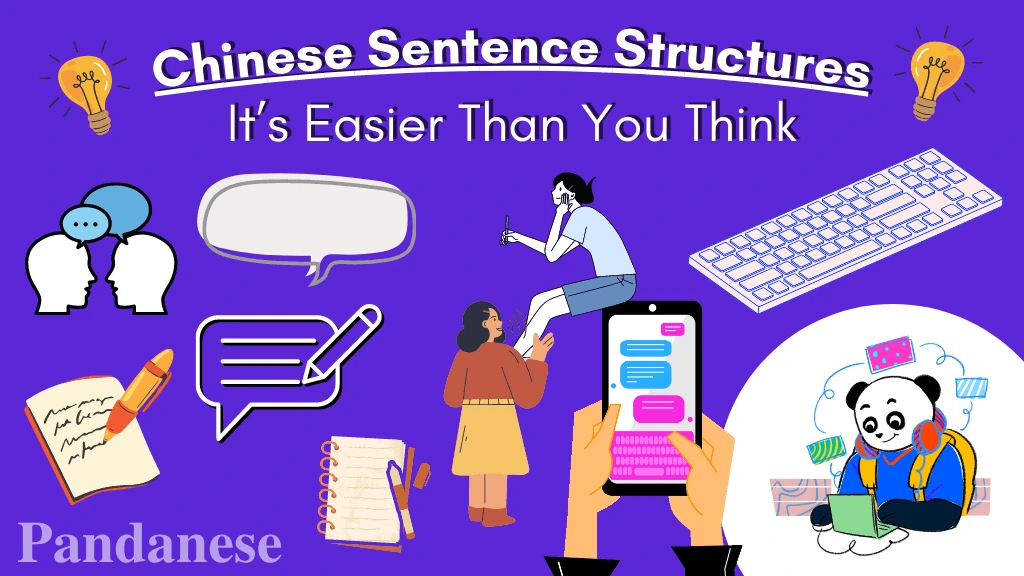
Chinese Grammar Might Be Easier Than You Think: A Beginner's Guide To Basic Chinese Sentence Structures
As a native English speaker, understanding the differences in Chinese sentence structure compared to European languages can be challenging. You must consider grammar points, complicated verb conjugations, masculine and feminine nouns and adjectives, singular and plural forms, exceptions, etc.
I'll start this article with some good news: you won't find any of that in Mandarin, as both Chinese verbs and Chinese adjectives have a fixed form: they don't change based on the number or gender of the subject.
It may sound confusing, and you may think that Chinese is a very imprecise language. However, along your learning journey, you'll learn that context is very important in Chinese, so only some things need to be expressed with grammar structures.
While Chinese is one of the most difficult languages in the world due to its unique and complicated writing system and vocabulary, Chinese grammar is not that complex. It is a very logical language, with a pretty straightforward sentence structure and fixed word order. But it can get tricky when you start learning advanced topics. So as a beginner, you'll find basic Chinese grammar much simpler than you thought it would be!
This article will prove just that by showing how basic Chinese grammar works and providing sentence examples. Let's check them out!
What are the basic Chinese sentence structure and word order?
First of all, let's look at the most basic Chinese sentences. Chinese is an SVO language, meaning the basic sentence structure of this language is the same as English: the subject precedes the verb, while the verb precedes the object.
1. SUBJECT + VERB
Similar to English, you only need a subject and a verb to form a grammatically correct Chinese sentence.
For example, we have two words: 我 (wǒ) means "I," 去 (qù) means 'go.'
Put two words together we have a sentence: 我去. (Wǒ qù.)—I go. Easy!
Here are more examples:
他吃. (Tā chī.)—he eats.
你要. (Nǐ yào.)—you want.
他笑. (Tā xiào.)—he laughs.

I study: 我学习 Wǒ xuéxí
2. SUBJECT + VERB + OBJECT
Usually, this format is for basic sentences. You add the direct object after the verb. Here are a few examples:
他吃苹果. (Tā chī píngguǒ.)—he eats apples.
你喝水. (Nǐ hē shuǐ.)—you drink water.

I study Chinese: 我学习汉语 Wǒ xuéxí Hànyǔ
To build up your Chinese vocabulary, use Pandanese. It use Spaced Repetition System with mnemonics to help Chinese-language learners memorize more Chinese characters (Hanzi) and vocabulary effectively. Once you start building up your vocabulary with Pandanese online or with the Pandanese app, you can start creating even more complex sentences.
3. SUBJECT + TIME WORDS + VERB + OBJECT
Place the time adverb (or any other adverb) before the verb if you want to add it. Sometimes, it's also ok to put it at the beginning of the sentence.
他早上吃苹果. (Tā zǎoshàng chī píngguǒ.)—he eats apples in the morning.
你常常喝水. (Nǐ chángcháng hē shuǐ.)—you often drink water.

I study Chinese everyday: 我每天学习汉语 Wǒ měitiān xuéxí Hànyǔ
4. SUBJECT + TIME WORDS + PREPOSITIONAL GROUP + VERB + OBJECT
If you want to add a prepositional group, a preposition, + a noun, you place it before the verb. This group can go before or after the adverb.
Look at some examples:
我和你都喜欢猫 (wǒ hé nǐ dōu xǐhuān māo)—me and you both like cats.
我常常给妈妈打电话 (wǒ chángcháng gěi māma dǎ diànhuà)—I often call my mum. (Lit. I often give a call to my mum.)
我下午在家看书 (wǒ xiàwǔ zài jiā kàn shū)—I read at home in the afternoon.

I study Chinese with my friend every day: 我每天跟朋友学习汉语 Wǒ měitiān gēn péngyou xuéxí Hànyǔ
This format is how Chinese grammar works. It's not that different from English, and you will learn it very easily.
What are some simple Chinese sentence structures?
Given the basics, we can look more in-depth at some simple structures that you can use to ask questions or create negative sentences.
1. Wh- questions
To use question words, remember that the word order doesn't change in Chinese. You place an interrogative pronoun or adverb in the right place.
Look at these sentences and corresponding wh- questions:

Original: I study Chinese with my friend every day: 我每天跟朋友学习汉语 Wǒ měitiān gēn péngyou xuéxí Hànyǔ
Suppose you want to know with whom someone studies Chinese every day. In that case, you replace the information you don't know about (朋友, friend) with the interrogative pronoun 谁, who. Then the sentence becomes:

With whom do you study Chinese with?: 你每天跟谁学习汉语? Nǐ měitiān gēn shéi xuéxí Hànyǔ?
Let's look at another one:

I read a book at home in the afternoon: 我下午在家看书 Wǒ xiàwǔ zài jiā kàn shū
Suppose you want to know when someone reads at home. In that case, you replace the information you're asking for, "afternoon," with the interrogative adverb 什么时候, when. So the sentence becomes:

When do you read a book at home?: 你什么时候在家看书?Nǐ shénme shíhou zài jiā kàn shū?
One more example:

She eats apples in the morning: 他早上吃苹果 Tā zǎoshang chī píngguǒ
Suppose you want to know what he eats in the morning. In that case, you replace the missing information, "an apple," with the interrogative pronoun 什么, what. The sentence becomes:

What does he eat in the morning?: 他早上吃什么?Tā zǎoshang chī shénme?
2. Yes/No questions with 吗 (ma)
The Chinese particle 吗 (ma) is used for yes/no questions. While English speakers have to change the order of the words to form a question, Chinese questions are much simpler: you need to add 吗 (ma) at the end of any statement to make a yes/no question in Chinese.
Let's look at the following example:
Start with a statement like 你喜欢咖啡. (Nǐ xǐhuān kāfēi)—you like coffee.
To turn the above statement into a yes/no question, add 吗 (ma) at the end of the sentence. We then have: 你喜欢咖啡吗? (Nǐ xǐhuān kāfēi ma?)—Do you like coffee?
Let's take a look at other examples:
你是中国人. (Nǐ shì zhōngguó rén.) You are Chinese.
你是中国人吗? (Nǐ shì zhōngguó rén ma?) Are you Chinese?
他喜欢猫. (Tā xǐhuān māo.) He likes cats.
他喜欢猫吗? (Tā xǐhuān māo ma?) Does he like cats?
他在喝水 (Tā zài hē shuǐ.) He is drinking water.
他在喝水吗? (Tā zài hē shuǐ ma?) Is he drinking water?
Note: you cannot add the 吗 (ma) particle at the end of a wh-question. If you're in doubt, ask yourself: is this a question I can reply with "yes" or "no" in Chinese? If yes, add 吗; if the answer has to be more elaborate, it's not a yes/no question.
3. Questions with 呢 (ne)
Another simple sentence structure that beginners can apply and start using today!
In conversations, you can add 呢 (ne) after a subject to ask someone the same question they just asked you "What about …?" In that way, you don't need to repeat the full question repeatedly.
For example, let's take a look at this conversation:
A: 你好吗? (Nǐ hǎo ma?)—How are you?
B: 我很好, 你呢? (Wǒ hěn hǎo, nǐ ne?)—I'm good, what about you?
A: 我也很好. (Wǒ yě hěn hǎo.)—I'm good, too.
As you can see, 呢 (ne) was tagged right after the person you want to ask the question. In this conversation, it's 你 (nǐ). So, 你呢 (nǐ ne) means 'What about you?'.
Other examples:
北京 下 雨 了. 上海 呢 ?(Běijīng xià yǔ le. Shànghǎi ne?)
It's raining in Beijing. How about Shanghai?
你 说 他们 可以 去. 我们 呢 ?(Nǐ shuō tāmen kěyǐ qù. Wǒmen ne?)
You said they could go. What about us?
A: 今天你忙吗? (Jīntiān nǐ máng ma?) – Are you busy today?
B: 不忙,你呢?(Bù máng, nǐ ne?) – No, what about you?
4. Sentences with 是 (shì)
是 (shì) has the closest meaning to the English verb 'to be.' (It's technically called a "copula.”) A sentence with 是 (shì) usually identifies people or things.
Use this verb with the usual SVO word order: Subject + 是 (shì) + object.
Below are some examples:
他是医生. (Tā shì yīshēng)—He is a doctor.
这是电脑 (zhè shì diànnǎo)—This is a computer.
我是老师 (wǒ shì lǎoshī)—I am a teacher.
那是手机 (nà shì shǒujī)—That is a phone.
Remember that you cannot switch the positions of the subject and object. For example:
✖️Incorrect: 学生是你. (Xuéshēng shì nǐ.)—Student are you.
✔️Correct: 你是学生. (Nǐ shì xuéshēng.)—You are a student.
Please note that the verb 是 is used to identify, meaning it tells what someone or something is. You can't use it as a perfect equivalent to the English verb "to be." For example, you can't use it to say "I'm here" (you're telling WHERE you are, you're not identifying yourself.) or "I'm hungry" (you're describing a condition, you are not identifying yourself).
5. Negative sentence structures
You usually keep the original basic structure (SVO) and put the adverb 不 (bù) before the verbs to negate a sentence. The word 不 (bù) functions like "not" in English.
Sentence structure: Subject + 不 (bù) + Verb + object.
Here are some examples:
Positive: 我喝酒. (Wǒ hējiǔ.)—I drink alcohol.
➞ Negative: 我 不 喝酒. (Wǒ bù hējiǔ.)—I don't drink alcohol.
Positive: 他们 想 工作. (Tāmen xiǎng gōngzuò.)—They want to work.
➞ Negative: 他们 不 想 工作. (Tāmen bù xiǎng gōngzuò.)—They don't want to work.
Positive: 你是学生. (Nǐ shì xuéshēng.)—You are a student.
➞ Negative: 你不是学生. (Nǐ bùshì xuéshēng.)—You are not a student.
Exception: For the verb 有 (yǒu)—you cannot use 不 (bù) to express its negative form. To talk about what you don't have, you use the adverb 没 (méi) instead.
Sentence structure: Subject + 没 (méi) + 有 (yǒu) + Object
Below are a few examples of 'not have' sentences:
我 没 有 手机. (Wǒ méi yǒu shǒujī.)—I don't have a cell phone.
我们 没 有 房子. (Wǒmen méi yǒu fángzi.)—We don't have a house.
我没有中国朋友. (Wǒ méi yǒu Zhòng uó péngyǒu.)—I don't have Chinese friends.
我的卡里没有钱. (Wǒ de kǎ lǐ méi yǒu qián.)—My card does not have money.
Frequently asked questions
How to structure a Chinese sentence?
There are four ways to structure a Chinese sentence:
SUBJECT + VERB
SUBJECT + VERB + OBJECT
SUBJECT + TIME WORDS + VERB + OBJECT
SUBJECT + TIME WORDS + PREPOSITIONAL GROUP + VERB + OBJECT
In conclusion
Those are the top 6 basic Chinese sentence structures that every beginner should know. We hope that you found this article useful!
Chinese grammar isn't as complex as you might think. The rules are straightforward to remember. Just remember the few exceptions!"
The easiest way to learn Chinese & build vocabulary

